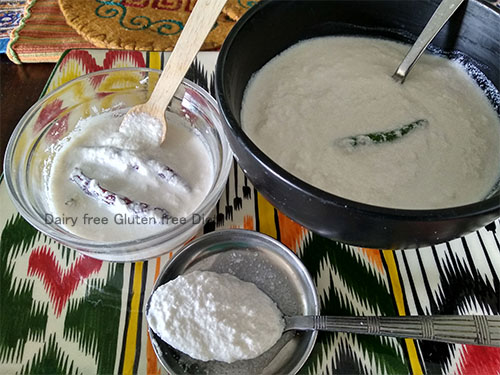
13 Apr Peanut Curd / Groundnut Yoghurt
All those who are ardent fans of yoghurt, miss it very badly when they adopt veganism. In South India, they make sure to include curds to kids right from the 1st year. Else, they fear, the child might not take to curd. And they insist that curd MUST be a part of your daily diet. As one who has been brought up in such surroundings, not surprisingly, I missed my curds very badly when I adopted veganism for health reasons. However, keeping my health in front, I went without curd for a year without knowing that there does exist plant- based & non dairy yoghurt / curd. Once I came to know about this peanut curd, there has been no looking back.
Of course, there are many plant-based milk such as almond milk, cashew milk, coconut milk, rice milk, soya milk, etc. But frankly, my almond milk and coconut milk never set. I generally avoid soya products. I didn’t try other two. But I succeeded with peanut milk and stuck to it.
Peanut curd, research says, has quite a few health benefits like healthy gut bacteria, rich in antioxidants and improves metabolism.
Many readers had asked what is groundnut / peanut curd and how it is prepared. I have already provided a recipe for groundnut curd mixed with ground rice / rice powder. This recipe does not use rice flour. Its more grainy than the earlier one. Groundnut being a legume, even if you are allergic to nuts, you can safely include it in your diet.
How do you set this peanut curd?
There are different ways for this.
- If you are a non vegan but want to try this just for the sake of it, you can set it with normal curd.
- Vegans who already have non dairy curd, can set it with that.
- People who have access to probiotic capsules can use them. However, I have not tried them and so cannot comment.
- You are a vegan and do not have vegan curd, not to worry. You can set with Chilli stems (crowns as some call it). I have tried both dry red chilli / green chilli with stems. However again, for me this method worked best when I set a small cup (1/4 cup– 60 ml) of peanut milk with 10 to 15 chilli stem / crowns. You can use this as the starter / Jaman to set further curds.
Peanut Curd / Groundnut Yoghurt
Ingredients
- ½ cup raw peanuts / groundnuts
- 1½ cups water
Instructions
- Wash the raw groundnuts and soak in water for a minimum of 6 hours.
- Drain and rinse well number of ttimes and grind to a very fine paste adding little water at a time.
- Use up all the water.
- At this stage you can either strain it or use it as it is.
- I prefer to strain it through a cheese cloth so that not much of pulp remain out. It is neither too thin, nor too thick.
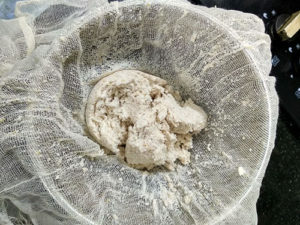
- Boil the strained milk till it comes up like normal milk.
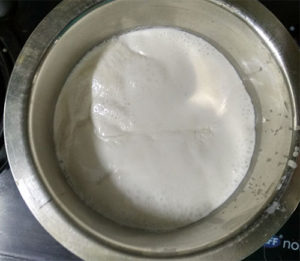
- Cool and when it is warm enough, set as explained in the post.
Notes
- I use 3 times water to grind the peanuts and extract the milk. However, for a thicker / thinner milk you can adjust the water.
- When I tried to set the entire curd with chilli stems / crowns, it took more than 24 hrs to set. But when I set a small quantity ( 1/4 cup) with green chilli crowns it got set overnight. However, people do succeed in setting the entire curd with chilli crowns. You can try.
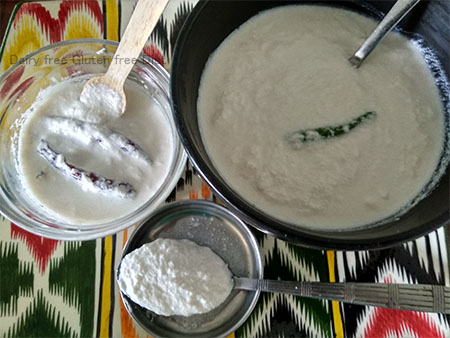
You can also check more recipes with groundnut curd here:



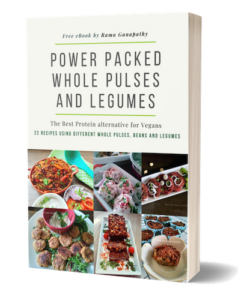

Renuka
Posted at 09:58h, 31 OctoberMy milk split while boiling / heating.
Is this normal?
Can I continue to use it?
ramag
Posted at 22:35h, 31 OctoberHi. No. it is not normal. It shouldn’t split. Mine never does. If there was any residue of some citric ingredient in the vessel, or in the spatula that is used to mix the milk, it might happen. Pl try to check your vessel when you make it again again and let know. As for the split milk, can you make paneer out of it? Please try. Rgds
Angulakshmi
Posted at 13:58h, 25 NovemberFor people with acidity n digestion problems is this easy to have
ramag
Posted at 14:45h, 27 NovemberHello. Firstly if you are allergic to peanuts, then it might cause you problems. In general, fermented foods are good for your tummy. But they can create problems for certain people. You need to check with your physician / dietitian / nutritionist for best results. please do let me know so that it benefits other readers too.
Subashini
Posted at 20:13h, 23 JulyHello Rama , Thank you for the recipe, How long can this curd be stored in fridge and used? I recently turned a vegan but my family is not , so I stole a bit of diary curd as starter for this :), How do I know that the curd is set just the texture change or is there anything in taste? Also can I add a bit of lemon along with the starter to make it a bit sour?
ramag
Posted at 20:53h, 23 JulyHi Subashini. Good to hear from you. Don’t worry. I’m the only vegan in my house of 4 and its ok to use dairy curd for a starter. 🙂 Firstly, this curd sets like a normal curd and you will know when it is set. It becomes thick and texture changes too. Secondly it stays good for long, just like normal curd. I make half a litre (Soak 1/2 cup (125 ml) peanuts, add 3 times water (375 ml) and grind it and strain it. Add 1 tbsp brown rice flour in 125 ml water and add at final stage of boiling. So Totally 500 ml). It lasts for me for a week. I have never seen it spoiling. Thirdly, yes, you can jolly well add Lemon juice to make it a little sour. You can add jaggery if you want it sweet. Like Mishti Doi. In my experience I’ve found that if you set it when the milk is hot (slightly hotter than lukewarm), it sets faster and thick. Enjoy being a vegan. Love
Subashini
Posted at 16:53h, 25 JulyThanks Rama, I liked it a lot, I will try to add lemon next time and see how it tastes. Also am going to try to make the cashew curd, sounds yum…..
Aabha B
Posted at 23:56h, 30 NovemberWhy do you add rice flour? Can we also replace brown rice flour with white rice flour?
ramag
Posted at 13:33h, 21 JanuaryHi. Sorry for the delayed response. Due to some personal reasons, I couldnt log in.
Anyways, Good to hear from you. The addition of rice flour is purely optional. It gives a creamy texture to the curd.
Secondly, yes, you can add brown rice flour as well instead of white rice flour.
Rgds
Preeti
Posted at 01:23h, 07 MarchI had followed every step and had also let it set for 8 hrs and more , but it was still very runny it didn’t set properly.
Is there any specifications where to keep it or in any recorded temperature?
ramag
Posted at 08:40h, 04 MayHi Preeti. Yes. I understand. The following factors cause runny curd.
1. Too much water. (The standard ratio is 1 cup raw peanuts : 3 or 4 cups water).
2. The quality of peanuts.
I had gone through this. Finally I realised it was the peanuts quality that didn’t produce the result. Now I buy only certain brand Organic Raw Peanuts which is giving me consistently good result. Try changing your peanuts. Once you start getting the result, you will enjoy this curd and will never go back to dairy curds.
Warm rgds
Nitin K Vijjan
Posted at 09:02h, 16 MayHi Rama,
I’m starting with it, to be vegan.
I tried making curd, but it didn’t settled even after 8 hours. Moreover it smelled horrific and my wife throwed it away.
But still have enough of milk in fridge. Does it smells that way with everyone or I’m wrong somewhere. Pls guide.
ramag
Posted at 08:37h, 22 JuneHi Nitin, Im surprised that your curd smelled and not surprised that your wife threw it. 🙂 Obviously, there must be something wrong. I keep making it every week. In fact made one just yday.
Did you use raw peanuts / groundnuts?
Were your groundnuts old? If they are very old, they might smell.
How long did you soak?
How did you ferment it?
Do you stay in a cold region?
I repeat the process again. Soak 1 measure raw groundnuts (preferably organic / or a good variety) for 4 hrs minimum. Grind slowly adding 3 to 4 measures of water till nuts grind well to a smooth paste. Pass through a nutmilk bag or a muslin cloth. Extract milk and boil till it comes up like normal milk does.
For fermenting for the first time, You can use 2 tbsps normal curd (if you do not mind).
Many people use probiotic capsules for fermentation. I have not used it and hence cannot comment.
Alternately take a small katori (about 20 to 25 gm) of groundnuts, make milk and boil as said above, add green chilli stems (atleast 10 to 20) / red chilli with stems. This process takes a minimum of 12 hrs to set. Use this for fermenting a large quantity of the milk.
Setting a large quantity of milk using chilli stems takes even 24 hrs at times and might start smelling if it does not succeed. You need to prepare a small quantity for making the culture if using chilli stems.
I do not understand how You store the milk. It does not stay that way dairy milk stays. Any home made plant based milk does not stay beyond 3 days even in refrigerator. Store bought ones do stay as they add preservatives.
Do let me know for further guidance.
Rgds